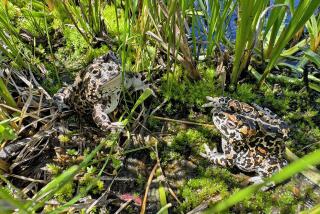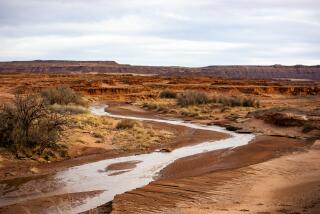First Known Frog Found on Navajo Land
- Share via
PHOENIX — In Navajo Indian legend, the frog is a deity who can make floodwaters recede and who plays a role in fertility.
For scientists, a frog discovered on the Navajo reservation in northeastern Arizona is providing something else: a window on evolution.
It was in Navajo territory that a team discovered fossils of what’s believed to be the earliest known frog. The fossils date back 190 million years, said Neil Shubin, a paleontologist at the University of Pennsylvania who published his results in a recent issue of the British scientific journal Nature.
The long-ago leaper even has a Navajo name, Prosalirus bitis. The Latin prosalir means “to leap forward,” and the Navajo bitis means “high over it.”
The fossils shed light on how frogs evolved. Shubin said the hind limbs, which are longer than its forelimbs, point to one of the main factors in what makes a frog a frog--its leap.
“Even though this is the earliest frog, it was clearly a good jumper,” he said. “It’s a very unique and specialized design that didn’t evolve overnight in a single step.”
The remains were unearthed in a dig in 1981 in a layer of rocks known as the Kayenta formation that dates back to the Jurassic period. Also unearthed at the site in what’s now a region of desert and cliffs were some of the earliest known mammals.
It took Shubin and a colleague nearly five years to sort out that the clump of fossils that looked like “road kill” actually had remnants of four different frogs. From there, it took a few more years to date the frogs and determine the significance of the find, he said.
“When you pull things out of the ground, they don’t look like much,” Shubin said.
The discovery adds to the evidence that frogs are survivors.
The 190-million-year-old fossil takes the amphibian back to the age when small dinosaurs roamed the area, then a land of rivers, streams and lakes.
Frogs have made it through drastic climate changes and mass extinction. Only now has the frog encountered a real threat--human activity, Shubin said.
“They survived climate changes so severe that it wiped out the dinosaur. Yet for some reason they’re not able to cope with what’s happening today,” he said.
Michael Morales, a paleontologist at the Museum of Northern Arizona, where the fossils will eventually be sent, said there is another frog fossil that could be the same age or older. Its age hasn’t been precisely determined, though, he said.
“The age is pretty clear on the one from Arizona,” Morales said.
Paleontologists are confident of the Arizona frog’s age because they’ve found other fossils from the formation which also date to the Jurassic age, said Northern Arizona University herpetologist Kiisa Nishikawa.
“It appears that the long-legged, jumping frog appeared relatively early and hasn’t changed much since it first appeared in the fossil record,” she said.
More to Read
Sign up for Essential California
The most important California stories and recommendations in your inbox every morning.
You may occasionally receive promotional content from the Los Angeles Times.













